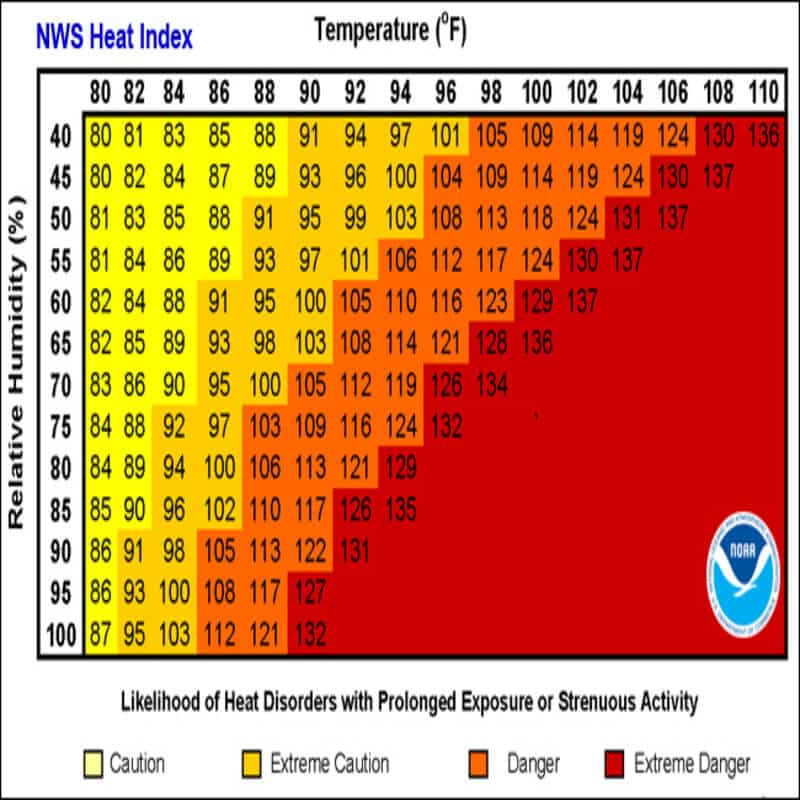
The India Meteorological Department (IMD) is planning to issue heat index readings for weather stations across India. It calculates the ‘real feel’ for issues with temperature readings. Read here to know how the heat index helps understand the rising temperatures better.
Traditional climate prediction models are becoming increasingly inaccurate as the consequences of the climate crisis worsen, highlighting the need for more sensitive mitigation and adaptation strategies.
The India Meteorological Department (IMD) made a step ahead by announcing intentions to calculate the “real feel” heat index to provide heat index (HI) measurements for meteorological stations.
This is a crucial step. Relative humidity, wind speed, maximum temperature, and cloud cover all need to be taken into account when determining how uncomfortable a person is.
What is the heat index?
The heat index, also known as the apparent temperature, is what the temperature feels like to the human body when relative humidity is combined with the air temperature.
This has important considerations for the human body’s comfort.
- When the body gets too hot, it begins to perspire or sweat to cool itself off.
- If perspiration is not able to evaporate, the body cannot regulate its temperature.
- Evaporation is a cooling process. When perspiration is evaporated off the body, it effectively reduces the body’s temperature.
- When the atmospheric moisture content (i.e. relative humidity) is high, the rate of evaporation from the body decreases.
- In other words, the human body feels warmer in humid conditions.
- The opposite is true when the relative humidity decreases because the rate of perspiration increases.
- The body feels cooler in arid conditions.
There is a direct relationship between the air temperature and relative humidity and the heat index, meaning as the air temperature and relative humidity increase, the heat index increases.
Relative humidity
It is the ratio of the amount of water vapor present in the air to the greatest amount possible at the same temperature.
It is a ratio, expressed in percent, of the amount of atmospheric moisture present relative to the amount that would be present if the air were saturated.
- Since the latter amount is dependent on temperature, relative humidity is a function of both moisture content and temperature.
How is the heat index calculated?

Robert G. Steadman devised the heat index in 1979.
The air temperature and the relative humidity readings are needed to determine the heat index using the above chart.
The heat index, like the wind chill index, makes assumptions about factors including clothing, amount of physical activity, personal heat tolerance, exposure to sunshine and UV radiation, and wind speed.
Heat index measurements that significantly deviate from this will not correctly reflect the perceived temperature.
Potential effects of heat index
As described above, the heat index is the temperature equivalent perceived by humans as a result of air temperature, relative humidity, and wind speed. This temperature can have potentially severe medical effects.
- Under high air temperature and humidity (high heat index) conditions, perspiration is hindered due to reduced evaporation as a result of high humidity.
- Sweat is the human body’s physiological response to high temperatures, and is an attempt to lower body temperature through the evaporation of sweat.
- When this is hindered, overheating and dehydration can occur, with varying severity.
- Exposure to full sunshine can increase heat index values by up to 8 °C (14 °F).
Celsius |
Fahrenheit |
Effect |
27-32°C |
80-90°F |
Caution: fatigue is possible with prolonged exposure and activity. Continuing activity could result in heat cramps. |
32-41°C |
90-105°F |
Extreme caution: heat cramps and heat exhaustion are possible. Continuing activity could result in heat stroke. |
41-54°C |
105-130°F |
Danger: heat cramps and heat exhaustion are likely; heat stroke is probable with continued activity. |
Over 54°C |
Over 130°F |
Extreme danger: heat stroke is imminent. |
For children, heat index numbers are especially crucial. Because of their small bodies and bigger skin surface compared to that of adults, children tend to produce more heat when they exercise, and they normally perspire less than adults. Children frequently have a lower awareness of the importance of rest and rehydration than adults do.
Maintaining hydration is crucial before, during, and after outdoor activities, especially those requiring strenuous physical activity, as thirst is a late symptom of dehydration.
- Also, children, who suffer from specific illnesses including obesity, diabetes, heart disease, cystic fibrosis, and mental retardation are more likely to become overheated and dehydrated.
Significance of heat index calculation
Heat waves are not easily photographed, like the destruction of tornadoes, hurricanes, and floods, and therefore tend not to have the same visual impact as these other disasters.
- Heat waves form when high pressure aloft, from 10,000 to 25,000 feet (3,000 to 7,600 meters), strengthens and remains over a region for several days up to several weeks.
- This is common in summer (in both the Northern and Southern Hemispheres) as the jet stream follows the sun.
- On the equator side of the jet stream, in the middle layers of the atmosphere, is the high-pressure area.
Hence, to protect life and property, measure how the hot weather “feels” to the body.
Limitations
- When there are severe situations, such as supersaturation of the air, when the air is more than 100% saturated with water, the heat index does not perform effectively.
- Additional difficulties with the heat index include the assumption that the individual is healthy and has easy access to water and shade.
- The lack of exact humidity data in many geographic areas also hinders the outcome.
-Article written by Swathi Satish






Leave a Reply